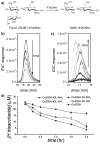Design of Artificial Glycosidases: Metallopeptides that Remove H Antigen from Human Erythrocytes
- PMID: 28128528
- PMCID: PMC5455340
- DOI: 10.1002/anie.201612079
Design of Artificial Glycosidases: Metallopeptides that Remove H Antigen from Human Erythrocytes
Abstract
Catalysts that promote carbohydrate degradation have a wide range of potential applications, but the use of either enzyme glycosidases or small-molecule catalysts in biological systems raises significant challenges. Herein, we demonstrate a novel strategy for the design of synthetic agents that mimic natural glycosidases and address current problems for biological use. This strategy is illustrated by application to the development of potential blood substitutes for the rare Bombay blood type that is characterized by a deficiency of H2 antigen. Metallopeptides with 16 to 20 amino acids were constructed as artificial fucosidases that exhibit selective carbohydrate cleavage reactivity toward l-fucose over d-glucose. Selective fucose cleavage from the H2-antigen saccharide enables efficient removal of H2 antigen from erythrocytes and thereby accomplishes the conversion of regular human type-O blood into a potential blood substitute for the rare Bombay blood type.
Keywords: bioinorganic chemistry; blood antigens; carbohydrates; enzymes; peptides.
© 2017 Wiley-VCH Verlag GmbH & Co. KGaA, Weinheim.
Figures


Similar articles
-
Metalloglycosidase Mimics: Oxidative Cleavage of Saccharides Promoted by Multinuclear Copper Complexes under Physiological Conditions.Inorg Chem. 2020 Aug 17;59(16):11218-11222. doi: 10.1021/acs.inorgchem.0c01193. Epub 2020 Jul 27. Inorg Chem. 2020. PMID: 32799467
-
Toward Efficient Enzymes for the Generation of Universal Blood through Structure-Guided Directed Evolution.J Am Chem Soc. 2015 May 6;137(17):5695-705. doi: 10.1021/ja5116088. Epub 2015 Apr 24. J Am Chem Soc. 2015. PMID: 25870881
-
Influence of stereochemistry and redox potentials on the single- and double-strand DNA cleavage efficiency of Cu(II) and Ni(II) Lys-Gly-His-derived ATCUN metallopeptides.J Am Chem Soc. 2007 Jul 4;129(26):8353-61. doi: 10.1021/ja0705083. Epub 2007 Jun 7. J Am Chem Soc. 2007. PMID: 17552522
-
Glycosidases in carbohydrate synthesis: when organic chemistry falls short.Chimia (Aarau). 2011;65(1-2):65-70. doi: 10.2533/chimia.2011.65. Chimia (Aarau). 2011. PMID: 21469448 Review.
-
Kinetics of Cu(II) complexation by ATCUN/NTS and related peptides: a gold mine of novel ideas for copper biology.Dalton Trans. 2021 Dec 20;51(1):14-26. doi: 10.1039/d1dt02878b. Dalton Trans. 2021. PMID: 34816848 Review.
Cited by
-
Design and directed evolution of noncanonical β-stereoselective metalloglycosidases.Nat Commun. 2022 Nov 11;13(1):6844. doi: 10.1038/s41467-022-34713-8. Nat Commun. 2022. PMID: 36369431 Free PMC article.
-
Oxidative Cleavage of Glycosidic Bonds by Synthetic Mimics of Lytic Polysaccharide Monooxygenases.Org Lett. 2022 May 13;24(18):3426-3430. doi: 10.1021/acs.orglett.2c01312. Epub 2022 May 3. Org Lett. 2022. PMID: 35503979 Free PMC article.
-
Analysis of Structure-Activity Relationships Based on the Hepatitis C Virus SLIIb Internal Ribosomal Entry Sequence RNA-Targeting GGHYRFK⋅Cu Complex.Chembiochem. 2017 Sep 5;18(17):1743-1754. doi: 10.1002/cbic.201700228. Epub 2017 Aug 7. Chembiochem. 2017. PMID: 28628737 Free PMC article.
-
Synthetic Glycosidase Distinguishing Glycan and Glycosidic Linkage in Its Catalytic Hydrolysis.ACS Catal. 2020 Dec 4;10(23):13800-13808. doi: 10.1021/acscatal.0c04038. Epub 2020 Nov 12. ACS Catal. 2020. PMID: 34123483 Free PMC article.
-
Metal complexes promoting catalytic cleavage of nucleic acids-biochemical tools and therapeutics.Curr Opin Chem Biol. 2018 Apr;43:37-42. doi: 10.1016/j.cbpa.2017.10.029. Epub 2017 Nov 15. Curr Opin Chem Biol. 2018. PMID: 29153936 Free PMC article. Review.
References
-
- Kren V, Thiem J. Chem Soc Rev. 1997;26:463–473.
-
- Sakurama H, Tsutsumi E, Ashida H, Katayama T, Yamamoto K, Kumagai H. Biosci Biotechnol Biochem. 2012;76:1022–1024. - PubMed
Publication types
MeSH terms
Substances
Grants and funding
LinkOut - more resources
Full Text Sources
Other Literature Sources

